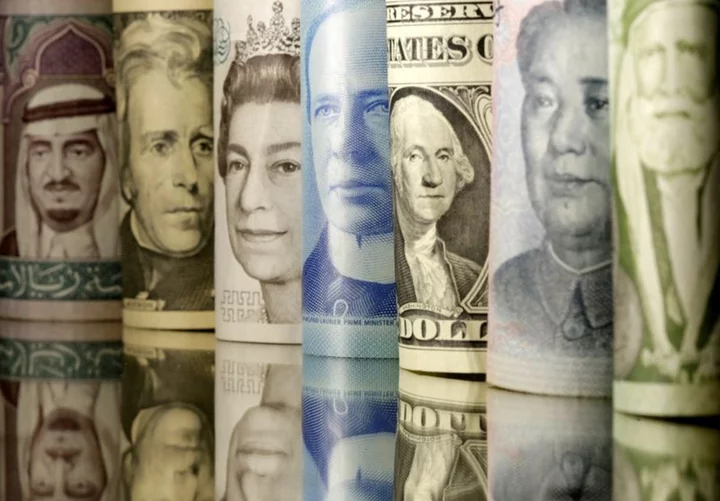By Mike Dolan
LONDON Buying into one of the biggest bubble bursts in history is brave and maybe even smart - but, like all market shocks, fraught in timing the turn.
Three years of plunging global bond prices and the resulting spike in yields shows few signs of abating - and it's all happening in some of the "safest" sovereign debt on the planet.
The reasons are all well documented - high inflation, tight labor markets, rising policy interest rates, unwinding central bank bond stashes and historically high and rising government deficits and debts. The 40-year bond bull market - a slow-inflating bubble like any other to some people - has crashed.
The scale of the drop in many long-term U.S. Treasury bond funds over the past three years is eye-watering - a price loss of more than 50% and counting from pandemic peaks of 2020. That's now on par with the gigantic S&P500 equity drawdowns of the dot.com bust and banking crash 15 years ago.
Benchmark U.S. Treasury yields across the maturity spectrum are climbing to 5% and beyond for the first time in more than 16 years and show few signs of cresting so far.
And yet survey evidence shows investors still loading up on bonds - just as they have through much of the persistent meltdown of the past six months that have seen 10-year Treasury yields pile on almost 175 basis points since March.
Bank of America's influential monthly fund manager survey shows global investors increased their net bond allocations again this month by 2 percentage points - the sixth straight month nursing a net overweight position now two standard deviations above long-term averages.
Is that just good money after bad - and the persistence of what now looks like a horrible contrarian indicator?
Against that, it's worth bearing in mind that global funds reported being net underweight bonds for more than 10 years prior to last December.
Perhaps significantly, the last time funds held such an overweight position on bonds for so long was during the banking crash and recession of 2008-2009 - when yields were near current levels and the Federal Reserve kicked off a quantitative easing policy that stacked its balance sheet full with Treasuries.
As such, funds may simply be seeing a natural top - the final deflation of a 15-year bubble and the prospect that swingeing central bank tightening will eventually see economic slowdown, if not recession, as corporate and household debt stress surely follows the credit squeeze.
2008... OR 2000?
Of course, bond bubbles and bursts - at least for top-rated sovereigns - are not same as their equity counterparts, even if the short-term performance of bond funds seems to ape them.
After all, you typically get your money back at par if you hold a bond to maturity and clip a now inflation-beating 5% coupon every year on top regardless of secondary market pricing.
Widening the lens of the bonds universe beyond sovereigns may be a different game - with all the riskier aspects of corporate default thrown into the mix.
But the widest cache possible of the bond universe shows a similar performance picture.
The Bloomberg Multiverse index of global government, supranational and corporate debt shows that rolling 12 month total returns - combining price and income - is back positive again, having spent more than two solid years in the red.
And the implied yield on the index has more than doubled in just 18 months to 4.65% - the highest since October 2008.
For pure income investors, or liability-matching pension or insurance funds, this is food and drink after years of yields of less than 2% - or near zero and below on some sovereign debt.
But for bond funds praying for a shorter-term price performance pickup, the situation looks nervier.
The yield on the 25-year-old Multiverse actually peaked in June 2000 at more than 6% - a very different landing zone.
Depending on your take on "higher-for-longer" policy rates, the structural switch to high pressure economies, central bank bond unwinds or even geopolitics and foreign central bank holdings, the timing of the turn may prove elusive.
And even if you get the maths of all that right, there now enters the relative unknown of what happens with unprecedented sovereign debt piles, new bond supply and likely tortuous attempts to rein in bloated post-pandemic government deficits.
That's why so much attention has lately fallen back on the nebulous "term premium" - a re-emerging risk premium demanded by investors to hold long-term bonds to maturity as opposed to rolling short-dated debt over the same time horizon.
While experts differ on both the measurement and direct causes of the term premium, the New York Fed's favoured model puts it back positive again to the tune of about 30 bps having spent most of the past eight years in negative territory.
Others estimate it's far higher.
Olivier Davanne at Paris-based advisory Risk Premium Invest says his model of this "buy and hold risk premium" suggests some 90bps of the 106bp rise in 10-year Treasury yields since midyear was down to this factor - with only 16 bps related to more aggressive pricing of long-term policy rates.
By his calculation this premium in 10-year bonds is higher than at any time since the 1990s at more than 100 bps - due variously to unpredictable debt supply dynamics, geopolitics, uncertainty on where inflation will be allowed to settle and a residual fear of many years of equity and bond correlation.
With such an ephemeral variable at work, picking a durable turn in the battered bond market may prove fiendishly difficult.
"In the "higher for longer" context, it is therefore difficult to have a firm view on the behavior of this key market in the months to come," Davanne said, adding he "certainly cannot rule out a further significant rise in long-term rates."
The opinions expressed here are those of the author, a columnist for Reuters.
(Mike Dolan, X:@ReutersMikeD)

